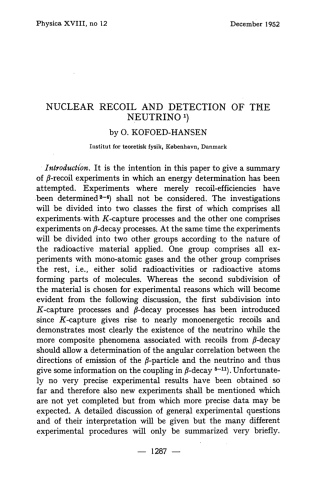NUCLEAR RECOIL AND DETECTION OF THE NEUTRINO

It is the intention in this paper to give a summary of β-recoil experiments in which an energy determination has been attempted. Experiments where merely recoil-efficiencies have been determined shall not be considered. The investigations will be divided into two classes.the first of which comprises all experiments with K-capture processes and the other one comprises experiments on β-decay processes. At the same time the experiments will be divided into two other groups according to the nature of the radioactive material applied. One group comprises all experiments with mono-atomic gases and the other group comprises the rest, i.e., either solid radioactivities or radioactive atoms forming parts of molecules.
The 6He experiment suffers from poor geometry but improvements are being made both in Urbana, in Columbia, and in the Cavendish laboratory. Furthermore, it should also be noted that" the charge of the recoils is not necessarily unity but may vary widely. Thus recoil measurements should be performed by methods where this charge does not enter. Such methods are the time of flight method and the current measurements in crossed electric and magnetic fields whereas the older experiments with retarding fields are seriously affected by the unknown charge zR. Theoretical estimates of zR 29) have shown that the experimental results of Allen, Paneth and Morrish on 6He has to be corrected by an amount of l0 pct. This of course adds to the conclusion drawn by the authors that their result is to be considered as tentative.